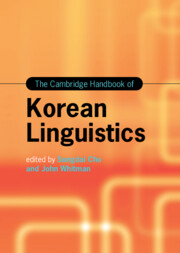Book contents
- The Cambridge Handbook of Korean Linguistics
- Cambridge Handbooks in Language and Linguistics
- The Cambridge Handbook of Korean Linguistics
- Copyright page
- Contents
- Figures
- Tables
- Contributors
- Preface
- Acknowledgments
- Abbreviations
- Part I Korean Overview
- Part II Phonetics and Phonology
- Part III Morphology and Syntax
- Part IV Semantics and Pragmatics
- Chapter 17 Subjectivity and Intersubjectivity in Korean Grammar
- Chapter 18 Discourse Studies in Korean
- Chapter 19 Metaphoric and Metonymic Patterns with the Body-Part Term Nwun “Eye(s)” in Korean
- Chapter 20 Wh-Indefinites
- Chapter 21 “Expletive” Negation in Korean
- Chapter 22 Case Stacking in Korean: Argument Structure or Information Structure?
- Part V Sociolinguistics and Psycholinguistics
- Part VI Language Pedagogy
- Index
- References
Chapter 17 - Subjectivity and Intersubjectivity in Korean Grammar
from Part IV - Semantics and Pragmatics
Published online by Cambridge University Press: 30 September 2022
- The Cambridge Handbook of Korean Linguistics
- Cambridge Handbooks in Language and Linguistics
- The Cambridge Handbook of Korean Linguistics
- Copyright page
- Contents
- Figures
- Tables
- Contributors
- Preface
- Acknowledgments
- Abbreviations
- Part I Korean Overview
- Part II Phonetics and Phonology
- Part III Morphology and Syntax
- Part IV Semantics and Pragmatics
- Chapter 17 Subjectivity and Intersubjectivity in Korean Grammar
- Chapter 18 Discourse Studies in Korean
- Chapter 19 Metaphoric and Metonymic Patterns with the Body-Part Term Nwun “Eye(s)” in Korean
- Chapter 20 Wh-Indefinites
- Chapter 21 “Expletive” Negation in Korean
- Chapter 22 Case Stacking in Korean: Argument Structure or Information Structure?
- Part V Sociolinguistics and Psycholinguistics
- Part VI Language Pedagogy
- Index
- References
Summary
Chapter 17 aims to give an integrated account of how subjectivity and intersubjectivity are coded in Korean sentence endings, how such suffixes are diachronically derived from their source constructions, and what typological and socio-cultural factors motivate the emergence and proliferation of such suffixes. The chapter surveys how suffixes index the speaker or both the speaker and addressee as an integral component in their semantic structure. It then examines how such (inter)subjective inflectional suffixes have diachronically been grammaticalized from non-subjective source constructions. The chapter shows that in Korean and in other languages, subjectification tends to lead to intersubjectification and not vice versa. Finally, the chapter argues that the relatively extensive diversity of inflectional suffixes in Korean, especially intersubjective suffixes, is due to two facts: 1) typologically head-final syntax and a typical agglutinative morphology and 2) the time-honored cultural values of hierarchism and collectivism as well as recent dynamic socio-economic mobilities in Korean society and culture.
Keywords
- Type
- Chapter
- Information
- The Cambridge Handbook of Korean Linguistics , pp. 489 - 523Publisher: Cambridge University PressPrint publication year: 2022



